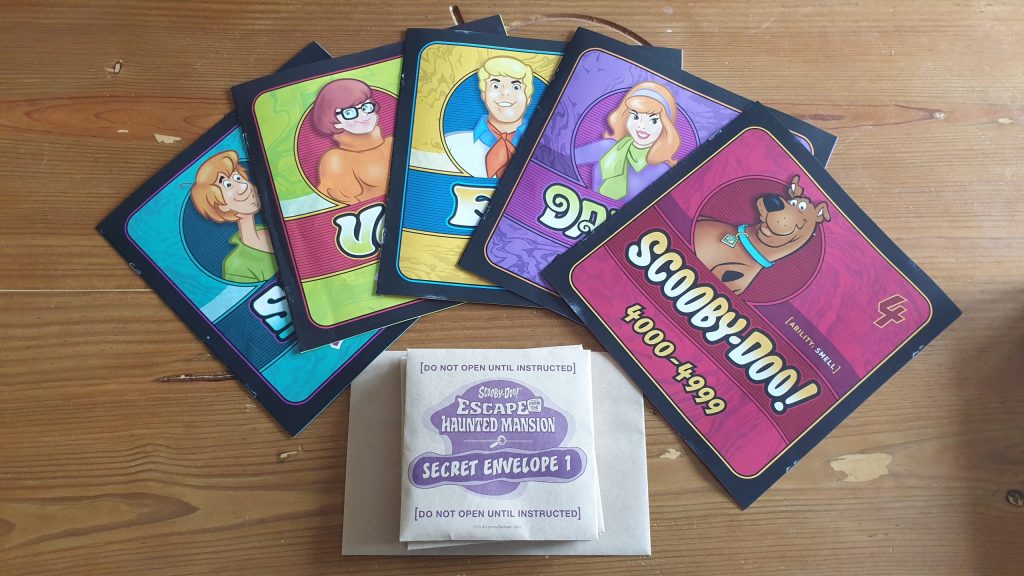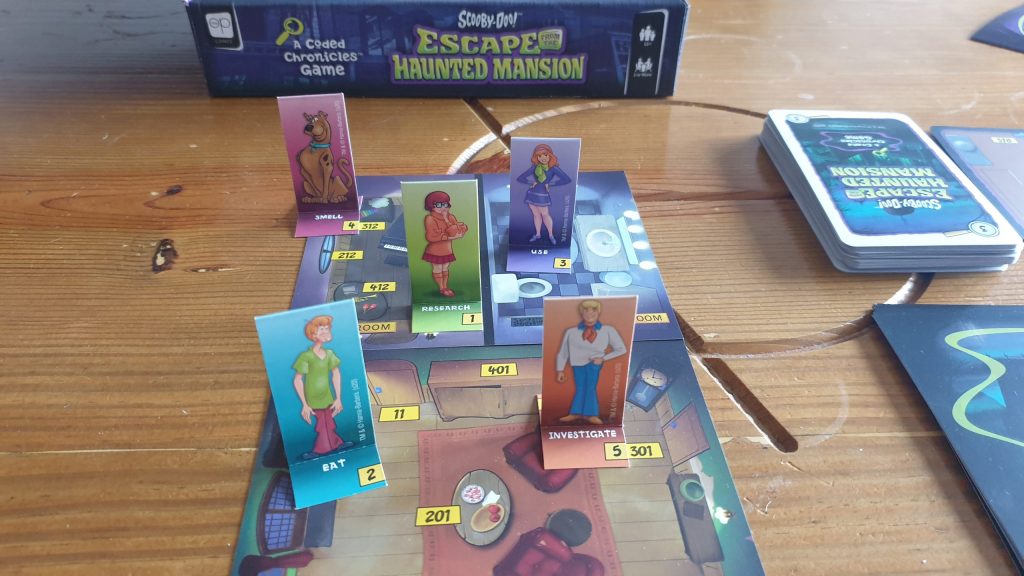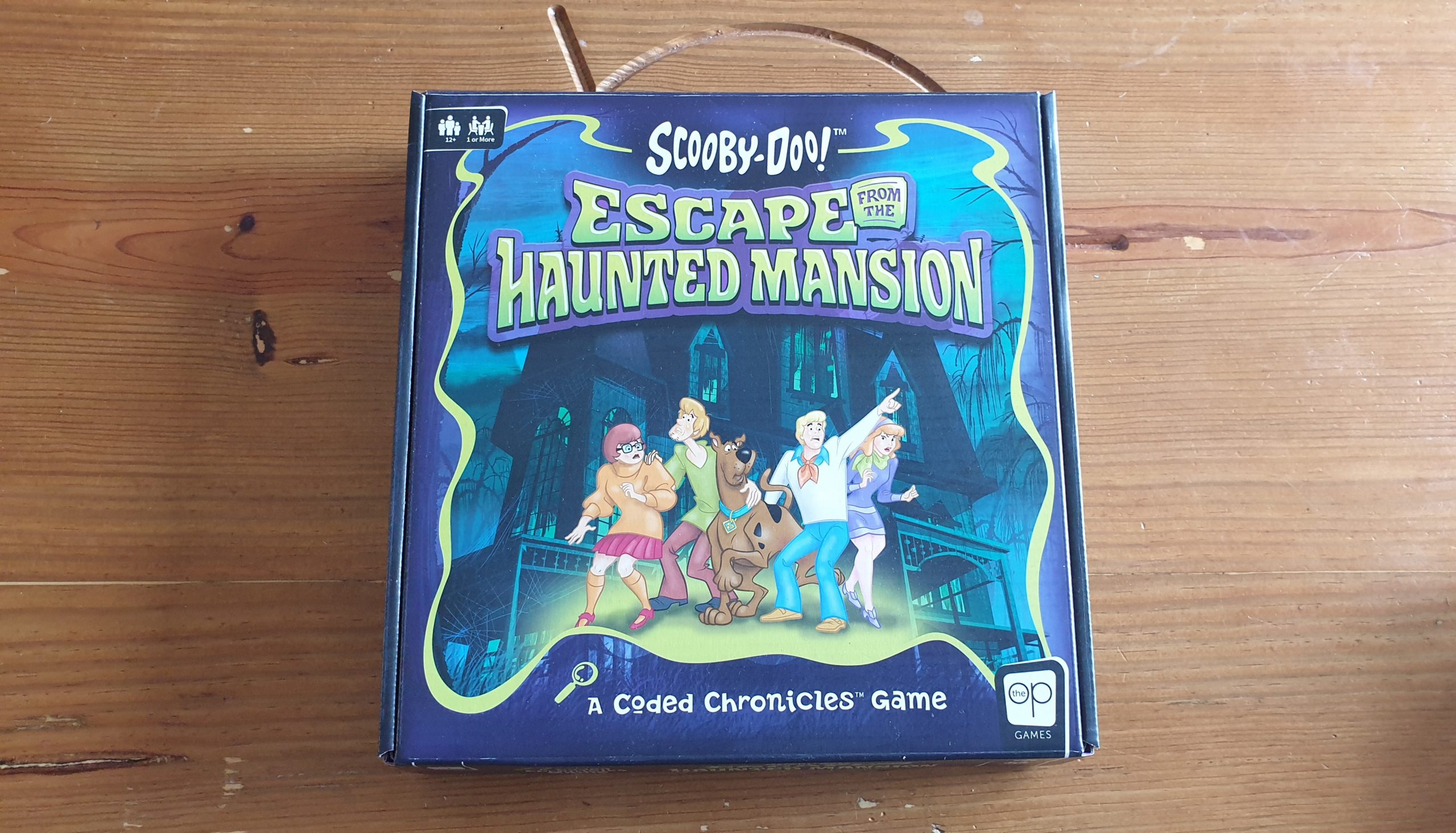Scooby-Doo Escape from the Haunted Mansion is a brand new cooperative, escape room style, board game from publisher The Op (previously USAopoly). Designed by Jay Cormier, Sen-Foong Lim and Kami Mandell, the game sees players working together as the Mystery Inc gang to solve the mystery of Lady Fairmont’s ghost. Playing in around 1.5 – 2 hours, this is the first installment of The Op’s Coded Chronicles series. Utilizing booklets full of narrative, map tiles to explore and secret envelopes to open, there’s a lot going for the game. However, is the game as much of a treat as a Scooby Snack? Let’s find out!
Starting out players take the booklets of Scooby-Doo and the Mystery Inc gang, though players aren’t necessarily taking up the roles of individual characters. Instead, players are more as a team playing as the whole gang, making choices together. With a bit of a monologue from Fred’s booklet, the scene is set and the gang have found themselves at Lord Fairmont’s mansion. Naturally, things aren’t exactly going swimmingly at the mansion, with the ghost of Lady Fairmont seemingly haunting the place. Starting out in the lobby the team will want to regroup and explore the mansion, looking for clues along the way.
Placing the first map tile, depicting the lobby, at the center of the table the team is ready to go. The game revolves around a system of 4 digit numbers. Each character of the Mystery Inc gang is numbered. Locations in the mansion then come with 3 digit labels. By combining the character value followed by the location value players will read passages from the indicated booklet. This is how the game progresses, both in storyline and getting to the bottom of what is truly going on!
As players explore the mansion map tiles will be added. The number of the new map tile, and where to place it, is denoted in the passage of text that is being read. Rooms aren’t just mentioned in the text. To make this process as simple as possible there will be a bullet point below the text stating map tile X. On top of this, there is a compass on the starting lobby tile – allowing the information to say the room is to be placed East of the Lobby as an example.

From interacting with locations players may acquire new items, which can be found in a numbered deck. Specific interactions can also cause something in the room to change, seeing a card found in the deck placed over a section of a map tile. Both of these uses can see new numbered locations or things to interact with become available. Some items will not have the standard 3 number combination, instead coming with only one number. This is to allow them to be used in conjunction with Daphne’s Use ability.
The team advances through the storyline by reading passages from the various character booklets. At times though there are puzzles for players to get involved with, adding in a spot of variety to the experience – and at times causing a spot of head scratching. None of these posed a huge game halting struggle, and by avoiding feeling impossible helped to keep all engaged. Some did take players a few minutes to crack, either by searching for specific things or a form of trial and error. Without going into detail there are some great uses for the cards, which players completely overlook until specific puzzles surface that may require them. The variety of puzzles and narrative helped to break the game up, as to not feel samey or stale, whilst keeping the general flow of the experience moving forward.
Players will be reading a lot from the booklets, and it is hard not to put on the voices of the famous characters when you read something they are saying. This is then amplified by the terrific effort that has gone into the writing of these booklets. Written in the ways that the characters speak, Fred normally gets to the point whilst Shaggy m…m…m….might stutter when spooky things start to occur, just like in the series.
With booklets like this often there is the worry of reading something you shouldn’t and spoiling a later event as a result. Scooby-Doo Escape from the Haunted Mansion gets around this by using an extremely clear and well laid out structure. At the left of the page are large 4 digit numbers, that start with the characters number. The sizing of the font makes it easy to flick through to find the correct passages to read, without reading the text of any others. There are also clear page lines between passages so that players don’t read too much. If this wasn’t enough a lot of the passages also have the map location they’d be read from as a final sense check for players before they start reading.
Each Mystery Inc. character gets a time to shine, even Scooby-Doo with is smell ability. While the game doesn’t say to pick characters, players naturally try to claim one of the character books from the get go. The plot requires the full gang, and it wouldn’t be the same without all of them being involved. As a result there is no way for characters to be left out, so if playing with less than 5 some will have to take 2+ booklets to read from. In our playthrough we did find that Shaggy did less reading than other characters. This isn’t necessarily a bad thing, as it means you could give that booklet to someone a little less confident about reading out loud – allowing them still to get involved but in a more comfortable way.

By giving the characters unique abilities it stops one of the Mystery Inc. gang from steamrollering through the adventure, with a few other mechanisms that surface to limit which members can get involved at a given time. As everyone has a favourite member it allows everyone to see their favourite character progress the adventure forward, when the others wouldn’t have been able to. Players could go around matching every single number, reading sections in their booklet out loud. Using a bit of logic of what players need to do at locations or with items will though often see one of the gang as the obvious choice to interact with a specific number. Plus, while completing the adventure is enough, some codes will see a scooby snack consumed – which is a negative for the team’s end score.
Like other escape room or storyline board games Scooby-Doo Escape from the Haunted Mansion is designed for a single playthrough. It would be possible to leave the box on the shelf for long enough to forget some of the characters and puzzles. Just like watching an actual episode though the chance of a small clue triggering your memory of the villain would be pretty high. Nothing in the box is used up. So, if players carefully pack the game away – returning content to the correct envelopes – it could be passed onto a different group to play.
While it is a plot to be played once there is a checkpoint system. Broken down into a couple of chapters, if tight on time players can save their progress at a specific point. This is done by putting cards and content they have available into a special chapter 2 envelope for a later date. Technically this could be performed at any point in the experience, though at select points the cards players should have available are listed. As a group we were in the groove of puzzle solving and wanted to play on. Nevertheless, it is nice that the option to pause the game for later was there – with it otherwise being the ideal comfort break time.
Scooby-Doo Escape from the Haunted Mansion managed to entertain a full 5 players for around an hour and a half. Often with escape room games too many cooks spoil the broth – which in this case wasn’t true. If players had to constantly be changing between booklets it would have been at the detriment of the experience, adding little pauses and slowing the game down. There are puzzles to solve and plot to unravel right down to the very end, then it comes time to decide as a team what’s really going on. It is no spoiler to say that the legendary line everyone is waiting to hear from the beginning is there, though will the Mystery Inc gang have earnt it? Well, that is up to the players to correctly identify the villain. Scooby-Doo Escape from the Haunted Mansion is the first in a series of games referred to as “Coded Chronicles”. If this is the quality of the series then gamers are in for more treats to come!
(Editor’s Note: Scooby-Doo Escape from the Haunted Mansion was provided to us by Asmodee for the review. The game is currently available from local board game stores, some of which are reopening! Find your local store here.)

